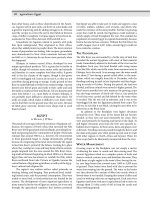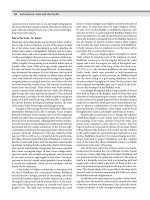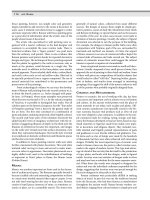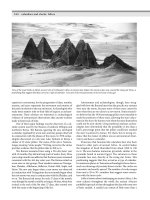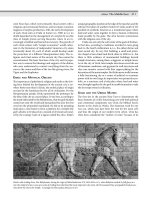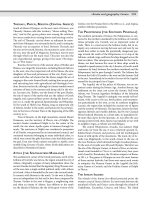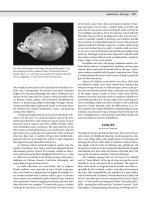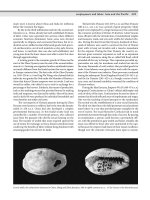Encyclopedia of society and culture in the ancient world ( PDFDrive ) 49
Bạn đang xem bản rút gọn của tài liệu. Xem và tải ngay bản đầy đủ của tài liệu tại đây (69.74 KB, 1 trang )
20
agriculture: Egypt
than other beans, such as those domesticated in the Americas. It grows well in poor soils, can thrive in some shade, and
is good for improving soils by adding nitrogen to it. Africans
used the cowpea to correct the soil in their fields in between
crops of millet or sorghum. Cowpeas appear to have been domesticated in West Africa between 2500 and 600 b.c.e.
Groundnuts are legumes related to peanuts with pods
that ripen underground. They originated in West Africa,
where they added protein to people’s diets. The most common
means of preparation was boiling. Like cowpeas, groundnuts
were domesticated in West Africa sometime between 2500
and 600 b.c.e.; historians do not know more precisely when
this happened.
Ethiopia, in eastern central Africa, developed its own
unique agricultural products. Tef is a grain that is similar to
millet, though tef contains more amino acids and minerals
and therefore is a more complete food than millet. It grows
well in the dry climate of the region, though it also grows
well in waterlogged soil. Insects do not eat it, so they are not
a problem during growing or storage. Cooks ground tef into
flour to make flatbread or boiled it to make porridge. Ancient
farmers also fed tef grain and stalks to their cattle and used
the stalks to reinforce their mud bricks. Tef was domesticated
some time before 1 c.e., most likely in western Ethiopia. It
was probably more difficult to domesticate than wheat. Tef
seeds are small, which makes it difficult to sow them evenly
and to find them on the ground once they are sown. Because
tef fields grow unevenly, farmers have always had to weed
them by hand.
EGYPT
BY
MICHAEL J. O’NEAL
Thousands of years ago, before the existence of Egyptian civilization, the regions of North Africa that surround the Nile
River were fertile grasslands and woodlands, providing farmland and grazing land for communities of people. Historians
estimate that around 3500 b.c.e., however, the environment
in these grasslands began to change dramatically, perhaps
because of overgrazing of the land, and eventually the region
turned into desert, primarily the Sahara. Looking for a place
where they could grow crops and keep herds of farm animals,
people migrated into the area around the Nile River, forming small settlements beginning in about 3000 b.c.e. Because
Egypt then and now has almost no rainfall, the Nile, which
flows northward from Lake Victoria in Uganda, became the
central feature of Egyptian agriculture, as well as of the Egyptians’ cultural and religious life.
The region’s very earliest settlers relied primarily on
hunting, fishing, and foraging. They produced food, including limited crops, only for personal consumption. They were
unable to store food, so food production was limited by the
seasons. The development of more organized agriculture in
many senses led to the rise of Egypt as a nation, for it was only
through the agricultural surpluses that farmers produced
that Egypt was able to take part in trade and support a class
of rulers, soldiers, scholars, civil servants, and others who
made the existence of the state possible. Further, by growing
crops that could be stored, the Egyptians could maintain a
steady supply of food throughout the year. This enabled the
population of ancient Egypt to expand dramatically, because
famine became far less common. Without the Nile River, the
world’s longest river at 4,037 miles, ancient Egypt could not
have existed as a nation.
THE FLOODPLAIN
The Nile River was surrounded by a fertile strip of land that
provided the ancient Egyptians with most of their material
needs. Immediately adjacent to the banks of the river was the
floodplain. Each year, this land flooded with rising waters
from the Nile, which was fed by water from monsoon rains in
Ethiopia, far to the south. In an average year, the water would
rise about 27 feet during a period called akhet, or the inundation, which ran roughly from July to December, with the
flooding reaching its peak in late September and then beginning to recede in October. During this period, the land was
flooded, and farm animals were moved to higher ground. The
flood waters provided not only moisture for growing crops
but also large amounts of fertile silt—that is, tiny particles
of soil that were carried and left behind by the water when
it receded. This silt was rich in nutrients, and it was in the
waterlogged silt that the Egyptians planted their crops. The
soil was so rich that it was black, causing the area often to be
referred to as the Black Land.
In addition to the floodplain were higher elevations
around the river. These areas of low desert did not become
flooded, so they were not used extensively for crops. They
were used primarily for hunting and burial of the dead. At
still higher elevations away from the river were sparsely inhabited desert regions. In these areas, dates and grapes were
cultivated. Traveling caravans passed through the desert, and
the dates and grapes were often picked up and used to trade
with other regions in North Africa and beyond. Water for
these crops had to be laboriously transported from the river.
WATER MANAGEMENT
Growing crops in the floodplain was not simply a matter
of allowing the water to recede and then sowing seed. The
ancient Egyptians relied on a complex system of locks and
dams to control, contain, store, and distribute the water. They
built dams at right angles to the water’s flow, forcing the water into large basins that covered some 1,000 to 4,200 acres
of ground. These basins were lined with clay to prevent the
water from seeping into the ground. The water in the basins
was then diverted by a system of dikes into canals, where it
flowed where it was needed. Keeping this system of dikes and
canals in working order was an ongoing task. Each year every
Egyptian (and most took part in agriculture) had to move on
average about 23 cubic yards of soil to keep the canals and
dikes working properly.
